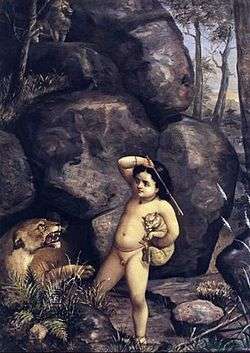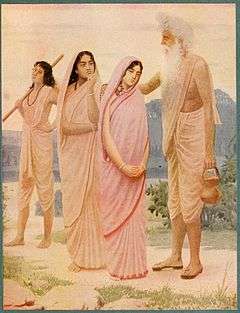Bharata (''Mahabharata'')
| Bharata | |
|---|---|
| Samrat | |
 Bharat plays with lion cubs Painting by Raja Ravi Varma | |
| Predecessor | Dushyanta |
| Successor | Bhumanyu |
| Born | Sage Kanva hermitage |
| Spouse | Sunanda |
| Dynasty | Lunar |
| Father | Dushyanta of Hastinapura |
| Mother | Śakuntalā |
In Hindu scriptures, Bharata (Sanskrit: भरत, translit. bharata, lit. 'The Cherished')[1][2] is an ancestor of the Pandavas and the Kauravas in the Sanskrit epic Mahabharata. Though the Bhāratas are a prominent community in the Rigveda,[3] the story of Bharata is first told in the Adi Parva of the Mahabharata, wherein he is the son of Dushyanta and Shakuntala.[4][5] The story of his parents and his birth is also related in Kalidasa's famous play Abhijñānashākuntala.
Bharata in Literature
According to the Mahābhārata (Adi Parva), Bharata was the son of King Dushyanta and Shakuntala and thus a descendant of the Lunar dynasty of the Kshatriya Varna.[6] He was originally named Sarvadamana ("the subduer of all"); the Mahābhārata traces the events in his life by which he came to be known as Bharata ("the cherished"). Bharata's exploits as a child prince are dramatised in Kalidasa's poetic play Abhijñānaśākuntalam.[7]
Story of Bharat

According to a dramatized version of the events by the poet Kalidasa, the king Dushyanta married Shakuntala on his hunting expeditions in forests. He was captivated by Shakuntala's beauty, courted her in royal style and married her. He then had to leave to take care of affairs in the capital.[8] She was given a ring by the king, to be presented to him when she was ready to appear in his court. She could then claim her place as queen. Shakuntala gave birth to her child who was named Sarvadamana by the sage Kanwa. Surrounded only by wild animals, Sarvadamana grew to be a strong child and made a sport of opening the mouths of tigers and lions and counting their teeth.[7]
This narrative varies dramatically from the version in the epic Mahabharata.[9]
Bharat performed many sacrifices and Sage Kanva was the chief priest at those sacrifices. Bharata performed a hundred horse sacrifices on the banks of the Yamuna, three hundred on the banks of Saraswati and four hundred on the banks of the Ganga. He again performed a thousand horse sacrifices and a hundred Rajasuya. He also conducted sacrifices such as Agnishtoma, Atiratra, Uktha and Viswajit. He also performed many thousands of Vajapeyas.[10]
Bharat had a son named Bhúmanyu. In the Adi Parva of Mahabharata, it tells two different stories about Bhúmanyu's birth. The first story says that Bharat married Sunanda, the daughter of Sarvasena, the King of Kasi Kingdom and begot upon her the son named Bhumanyu.[11] According to the second story, Bhúmanyu was born out of a great sacrifice that Bharata performed for the sage Bharadwaja.[12]
Bharata lineage
Emperor Bharat gave his name to the dynasty of which he was the founder. It was in the Bharat's' dynasty that later the Pandavas of epic Mahabharata were born.[13]
See also
Notes
- ↑ Mahabharata, Adi Parva, Sambhava Parva
- ↑ Mahabharata, Adi Parva, Sambhava Parva (in Sanskrit)
- ↑ Singh, U. (2009), A History of Ancient and Medieval India: From the Stone Age to the 12th Century, Delhi: Longman, p. 187, ISBN 978-81-317-1677-9
- ↑ Apte, Vaman Shivaram (1959). "भरतः". Revised and enlarged edition of Prin. V. S. Apte's The practical Sanskrit-English dictionary. Poona: Prasad Prakashan.
- ↑ Buitenen, J. A. B. van (1973). "Introduction". Mahabharata Book I: The book of beginnings. University of Chicago Press. ISBN 9780226846637.
- ↑ The Mahābhārata. Buitenen, J. A. B. van (Johannes Adrianus Bernardus), 1928-1979,, Fitzgerald, James L. Chicago: University of Chicago Press. 1973. p. 214. ISBN 0226846636. OCLC 831317.
- 1 2 Ganguly 1883, pp. 130–132.
- ↑ Kālidāsa. (1984). Theater of memory : the plays of Kālidāsa. Miller, Barbara Stoler. New York: Columbia University Press. pp. 109, 122. ISBN 0231058381. OCLC 10299417.
- ↑ Macfie, J. M (1993). Myths and Legends of India. New Delhi: Rupa & Co. p. 323. ISBN 978-81-7167-131-1.
- ↑ Ganguly 1883, pp. 130–131.
- ↑ Mahabharata, Adi Parva, Sambhava Parva - Bharat Vamsha in Detail Archived 16 January 2010 at the Wayback Machine.
- ↑
- ↑ Donald A 1913, p. 157.
References
- KM, Ganguly (2006) [1883], The Mahabharata of Krishna-Dwaipayana Vyasa (Drona Parva Section LXVIII ed.), Sacred Texts
- Mackenzie, Donald A, Indian Myth and Legend, Sacred Texts
External links
- Indian Myth and Legend, CHAPTER IX: Prelude to the Great Bharata War, Sacred Texts.com
